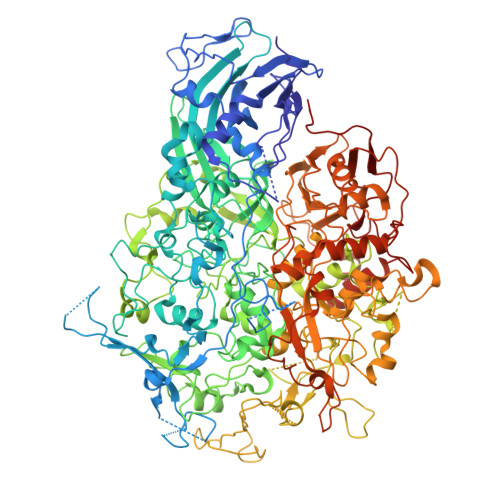Immunodominant proteins P1 and P40/P90 from human pathogen Mycoplasma pneumoniae.
Vizarraga, D., Kawamoto, A., Matsumoto, U., Illanes, R., Perez-Luque, R., Martin, J., Mazzolini, R., Bierge, P., Pich, O.Q., Espasa, M., Sanfeliu, I., Esperalba, J., Fernandez-Huerta, M., Scheffer, M.P., Pinyol, J., Frangakis, A.S., Lluch-Senar, M., Mori, S., Shibayama, K., Kenri, T., Kato, T., Namba, K., Fita, I., Miyata, M., Aparicio, D.(2020) Nat Commun 11: 5188-5188
- PubMed: 33057023
- DOI: https://doi.org/10.1038/s41467-020-18777-y
- Primary Citation of Related Structures:
6RC9, 6RJ1, 6TLZ, 6TM0, 7BWM - PubMed Abstract:
Mycoplasma pneumoniae is a bacterial human pathogen that causes primary atypical pneumonia. M. pneumoniae motility and infectivity are mediated by the immunodominant proteins P1 and P40/P90, which form a transmembrane adhesion complex. Here we report the structure of P1, determined by X-ray crystallography and cryo-electron microscopy, and the X-ray structure of P40/P90. Contrary to what had been suggested, the binding site for sialic acid was found in P40/P90 and not in P1. Genetic and clinical variability concentrates on the N-terminal domain surfaces of P1 and P40/P90. Polyclonal antibodies generated against the mostly conserved C-terminal domain of P1 inhibited adhesion of M. pneumoniae, and serology assays with sera from infected patients were positive when tested against this C-terminal domain. P40/P90 also showed strong reactivity against human infected sera. The architectural elements determined for P1 and P40/P90 open new possibilities in vaccine development against M. pneumoniae infections.
Organizational Affiliation:
Instituto de Biología Molecular de Barcelona (IBMB-CSIC), Parc Científic de Barcelona, Baldiri Reixac 10, 08028, Barcelona, Spain.
















